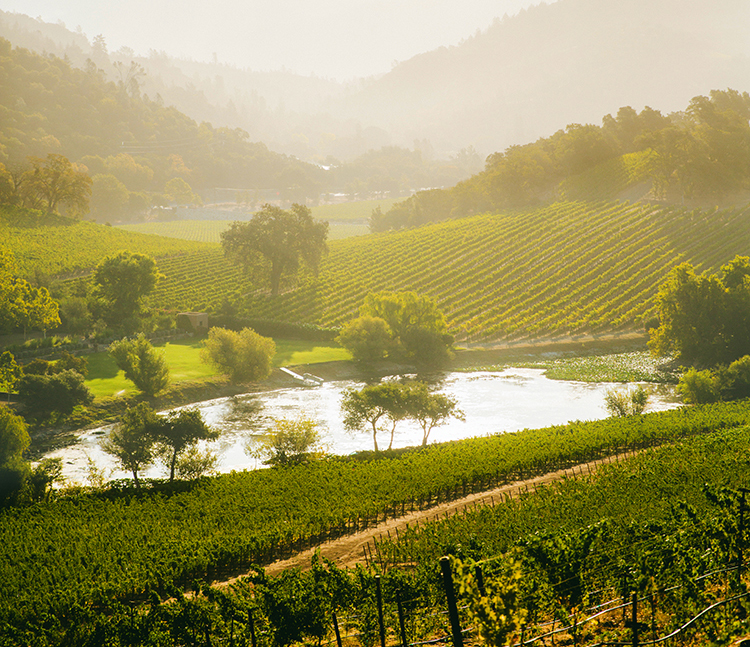
A Vineyard in Full Voice and a Wine of Perfect Harmony.
It was a warm, dry spring in Napa Valley, and budbreak came early. Only one bout of heat in late June 2013 interrupted the mild weather, but it was over by Independence Day. Winemaker Charles Thomas knew he was witnessing the start of an ideal growing season—incredibly, one that might even surpass the near-perfect conditions of 2012. The grapes, still weeks away from harvest, were brimming with intense character and the flavors of dark fruit, cherry, and plum. “It just kept building; you almost didn’t want to say it out loud—you don’t want to jinx it!” Thomas recalls. “But everything was lining up, and everything kept lining up.”
The 2013 vintage in the Napa Valley was barely in the bottle before it was being declared the finest vintage in decades. The wine critic Robert M. Parker has already christened it “the game changer,” the best vintage he has experienced in the 37 years he has visited Napa, and said of Quintessa in particular: “the most profound Quintessa made to date.” In Wine Spectator, James Laube called the 2013s “dazzling,” while Antonio Galloni said it was “an epic vintage in the making” in Vinous.
Such effusiveness may have also come early, but it is understandable. Great vintages come along every few years in major wine regions, but two in a row? The occurrences are so rare, they can be counted on one hand: The 1989 and 1990 Barolos in Piedmont, the 2001 and 2002 in Burgundy’s Côte de Nuits, the 2009 and 2010 in Bordeaux. And now, Napa Valley’s 2012 and 2013 are another set of vintages that connoisseurs will compare and acclaim for decades.
In the ideal season of 2013, the 26-year-old vines at Quintessa were singing, each of the 26 blocks in tune with the others. For every variety—Cabernet Sauvignon, Merlot, Cabernet Franc, Petit Verdot, and Carmenere—harvest was handled one block at a time, though in most cases the blocks were divided into smaller sections, making it possible to pick at the moment the fruit was showing its best character.
The harvest also reaped the benefit of decades of dedication on the part of Quintessa’s founders, Agustin and Valeria Huneeus, who bought the 280-acre estate in Rutherford when it was entirely raw, wild land. They recognized that its unique terroir—the range of soils, microclimates, and exposures created by the estate’s five hills, lake and riverbed, and surrounding forest—could create a red wine to rival the best in the world. Valeria, a microbiologist and viticulturalist, designed each plot to take full advantage of its location, and from the beginning farmed it organically, a bold idea in the Napa of 1990.
“The 2013 is one of the most incredible vintages to date,
one of the pinnacles of Napa, and it certainly brings
the Quintessa wines to a whole new level.”
Over the years, the property produced consistently remarkable wines, each expressing its particular nuances. But it is hard not to see 2013 as a culmination of the original vision, as the weather, the vineyard, and the winemaking came together to produce a wine of exceptional power and grace. “I essentially took full advantage of the richness and intensity coming from the vineyard,” Thomas says. “Agustin has always had a sense of what he calls ‘the European aesthetic’—the finesse part of wine—and Quintessa has done the finesse and elegance part of it very well throughout its history. In 2013 we had the potential for power and density without giving up one molecule of nuance, and we seized the moment.”
This would also turn out to be Thomas’s last full vintage at Quintessa as he turns the reins over to his protégé, Rebekah Wineburg, and becomes Quintessa’s Winemaker Emeritus. Wineburg—who had worked with Thomas at Rudd Estate in Napa and was previously winemaker at Buccella—came onboard during the final blending of Quintessa’s 2013, the first step in a seamless transition. “We have a very similar sensibility about wine,” she says, “and it’s really helpful to have that rapport and that same vision. I can continue on in the direction he helped map out for Quintessa.”
That continuity reflects what Agustin Francisco Huneeus, the son of Agustin and Valeria, calls Quintessa’s “generational” approach to the business. “People will say Quintessa is run by a family,” he says, “but that doesn’t quite capture the nuance of our approach, which is one of longevity and evolution.” (And in another moment of succession, Agustin Francisco will be this year’s honorary event chair at Auction Napa Valley in June, exactly 20 years after his father held the same post.)
The wine media may have declared 2013 the supreme vintage in modern memory, yet for the Quintessa team, celebrating this wine is not about deciding which year is best, but about appreciating what makes 2013 unique.
Larry Stone, master sommelier and wine director for Huneeus Vintners, points out that the 2013, “right out of the chute, has more richness, more softness, more complex tannin—which seems silkier and smoother on the palate.” It is a wine that is drinking beautifully right now, but has the potential to evolve over the next 25 years.
Wineburg appreciates the 2013’s particular intensity. “In the aroma, there’s cassis, tobacco leaf, fresh cherries, and floral notes,” she says. “It still has the brightness you expect with Quintessa, but there’s also a density—and the finish is long, yet supple and silky.”
Thomas, as one would expect, is reluctant to single out a favorite child among his nine Quintessa releases. But it’s impossible not to ask, did his last vintage turn out to be his best? After a pause, he allows: “It could well be the vintage of my career.” •
